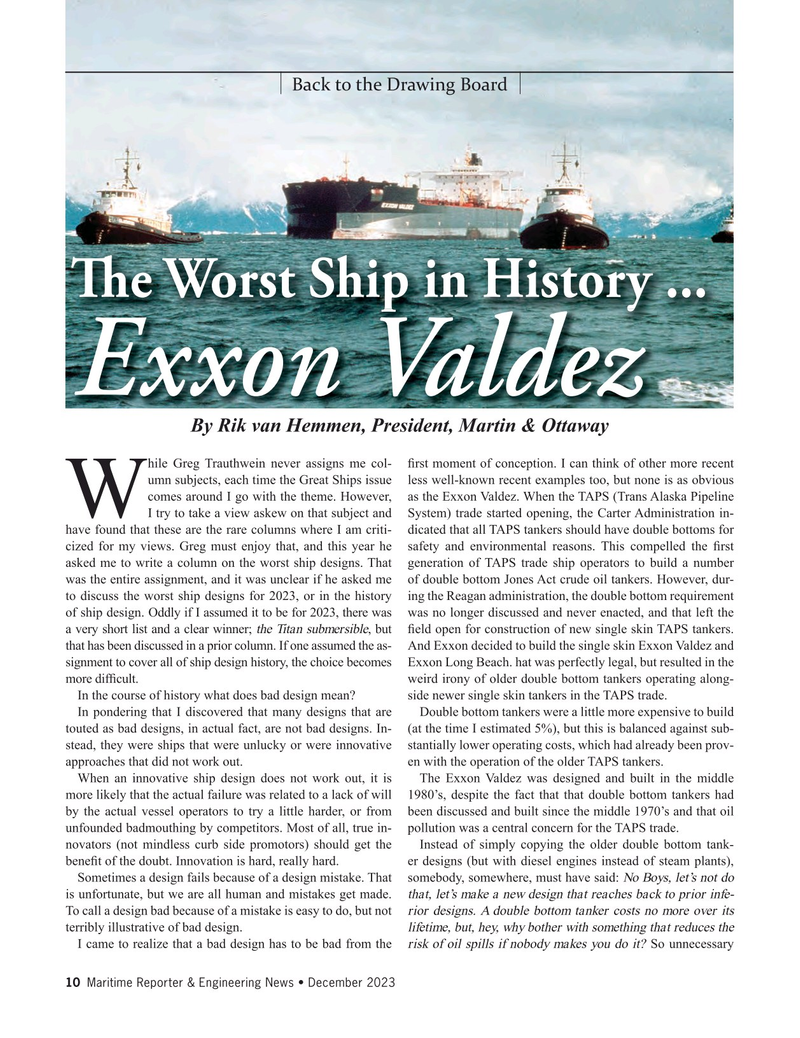
Page 10: of Maritime Reporter Magazine (December 2023)
Great Ships of 2023
Read this page in Pdf, Flash or Html5 edition of December 2023 Maritime Reporter Magazine
Back to the Drawing Board
T e Worst Ship in History ...
Exxon Valdez
By Rik van Hemmen, President, Martin & Ottaway hile Greg Trauthwein never assigns me col- ? rst moment of conception. I can think of other more recent umn subjects, each time the Great Ships issue less well-known recent examples too, but none is as obvious comes around I go with the theme. However, as the Exxon Valdez. When the TAPS (Trans Alaska Pipeline
WI try to take a view askew on that subject and System) trade started opening, the Carter Administration in- have found that these are the rare columns where I am criti- dicated that all TAPS tankers should have double bottoms for cized for my views. Greg must enjoy that, and this year he safety and environmental reasons. This compelled the ? rst asked me to write a column on the worst ship designs. That generation of TAPS trade ship operators to build a number was the entire assignment, and it was unclear if he asked me of double bottom Jones Act crude oil tankers. However, dur- to discuss the worst ship designs for 2023, or in the history ing the Reagan administration, the double bottom requirement of ship design. Oddly if I assumed it to be for 2023, there was was no longer discussed and never enacted, and that left the a very short list and a clear winner; the Titan submersible, but ? eld open for construction of new single skin TAPS tankers. that has been discussed in a prior column. If one assumed the as- And Exxon decided to build the single skin Exxon Valdez and signment to cover all of ship design history, the choice becomes Exxon Long Beach. hat was perfectly legal, but resulted in the more dif? cult. weird irony of older double bottom tankers operating along-
In the course of history what does bad design mean? side newer single skin tankers in the TAPS trade.
In pondering that I discovered that many designs that are Double bottom tankers were a little more expensive to build touted as bad designs, in actual fact, are not bad designs. In- (at the time I estimated 5%), but this is balanced against sub- stead, they were ships that were unlucky or were innovative stantially lower operating costs, which had already been prov- approaches that did not work out. en with the operation of the older TAPS tankers.
When an innovative ship design does not work out, it is The Exxon Valdez was designed and built in the middle more likely that the actual failure was related to a lack of will 1980’s, despite the fact that that double bottom tankers had by the actual vessel operators to try a little harder, or from been discussed and built since the middle 1970’s and that oil unfounded badmouthing by competitors. Most of all, true in- pollution was a central concern for the TAPS trade.
novators (not mindless curb side promotors) should get the Instead of simply copying the older double bottom tank- bene? t of the doubt. Innovation is hard, really hard. er designs (but with diesel engines instead of steam plants),
Sometimes a design fails because of a design mistake. That somebody, somewhere, must have said: No Boys, let’s not do is unfortunate, but we are all human and mistakes get made. that, let’s make a new design that reaches back to prior infe-
To call a design bad because of a mistake is easy to do, but not rior designs. A double bottom tanker costs no more over its terribly illustrative of bad design. lifetime, but, hey, why bother with something that reduces the
I came to realize that a bad design has to be bad from the risk of oil spills if nobody makes you do it? So unnecessary 10 Maritime Reporter & Engineering News • December 2023
MR #12 (1-17).indd 10 12/5/2023 9:49:38 AM

 9
9

 11
11
